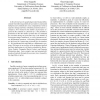Free Online Productivity Tools
i2Speak
i2Symbol
i2OCR
iTex2Img
iWeb2Print
iWeb2Shot
i2Type
iPdf2Split
iPdf2Merge
i2Bopomofo
i2Arabic
i2Style
i2Image
i2PDF
iLatex2Rtf
Sci2ools
ISPAN
2002
IEEE
2002
IEEE
Automatic Processor Lower Bound Formulas for Array Computations
In the directed acyclic graph (dag) model of algorithms, consider the following problem for precedence-constrained multiprocessor schedules for array computations: Given a sequence of dags and linear schedules parameterized by Ò, compute a lower bound on the number of processors required by the schedule as a function of Ò. This problem is formulated so that the number of tasks that are scheduled for execution during any fixed time step is the number of non-negative integer solutions Ò to a set of parametric linear Diophantine equations. Generating function methods are then used for constructing a formula for the numbers Ò. We implemented this algorithm as a Mathematica program. This paper is an overview of the techniques involved and their applications to well-known schedules for MatrixVector Product, Triangular Matrix Product, and Gaussian Elimination dags. Some example runs and automatically produced symbolic formulas for processor lower bounds by the algorithm are given.
Directed Acyclic Graph | Distributed And Parallel Computing | ISPAN 2002 | Lower Bounds | Precedence-constrained Multiprocessor Schedules |
| Added | 15 Jul 2010 |
| Updated | 15 Jul 2010 |
| Type | Conference |
| Year | 2002 |
| Where | ISPAN |
| Authors | Peter R. Cappello, Ömer Egecioglu |
Comments (0)

